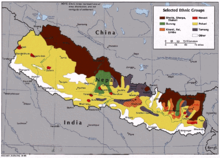Khas people
Khas people (Nepali: खस जाति) are an ethno-linguistic group. They are indigenous native speakers of Nepali language (Khas Kura; translit.Khas speech) which is an Indo-Iranian language. Khas people have been referred as Parbatiya and Pahari or Gorkhali. Khas are most dominant faction in Nepal. They are around 31% of Nepal but nearly two thirds of government officials. The word “Khas” is little used in modern times. Khas peoples call themselves by their group names such as Bahun, Kshetri, Sanyasi/Sannesi, Kami, Damai, etc.
 Sample photo of Khas man in the scholarly work at Library of India | |
| Total population | |
|---|---|
| c. 16 million[1] | |
| Regions with significant populations | |
| Languages | |
| Nepali language (Khas Kura) as mother tongue | |
| Religion | |

Modern day
changeKhas people continue Hindu religion with some ancestral deity called Masto gods.
Khas family names
changeBahun, Chhetri & Thakuri
changeAcharya, Adhikari, Arya, Aryal, Bam, Badola, Saun (Saud or Samant), Bagadwal, Baral, Basnet/Basnyat, Barmola, Bhandari, Bhattarai, Bista/Bisht, Bhatta, Bhetwal, Budhathoki, Chand, Chauhan, Chaulagain, Chhetri, Dahal, Dabral, Devkota, Dhakal, Dhital, Dimri, Dhungel, Dobhal/Doval, Dobriyal, Dulal, Gautam, Gusain, Ghimire, Joshi, Kalauni, Karki, Kattel, Katuwal, Kandari, Kukreti, Khand, Khadka, Khanal, Khatri/K.C., Koirala, Kunwar , Lamsal, Lekhak, Lohani, Oli, Mainali, Negi, Nautiyal, Neupane, Nouni, Pathak, Panta, Pandey, Hamal, Malla, Mamgain Poudel/Paudyal/Poudar(hill), Pokharel, Rana, Raut, Ranabhat, Rawat, Rautela, Raturi, Rijal, Regmi, Rimal, Sitoula, Sapkota, Shah, Sen, Shahi, Silwal, Semwal, Sharma, Singh, Thakur/Thakuri, Thapa, Thapliyal, Upreti, Upadhyay, Wagle, Wasti, Air, Aidi, Kandwal, khadayat, kathayat, pela, bhat, ter, bohra, pali, budal, chaisir, danga, rawal, pujara, mahat, mahra etc.
(Dasnami)
changePuri, Saraswati, Bharati: Bhaveswa Tirtha, Ashram: Adhigata Ban, Aranya: Kashyap Giri, Parvat, Sagar :Bhrigu
Khas Dalits
changeBadi, Bishwakarma/B.K., Damai, Dholi, Gandharbha, Kami, Nagarchi, Pariyar, Ranapaheli, Sarki, Sundas, etc.
References
changeCitations
change- ↑ "Nepali (npi)". Ethnologue. Retrieved 6 October 2016.
Books
change- John T Hitchcock (1978), Himalayan Anthropology: Indo-Tibetan interface, Walter de Gruyter, ISBN 9789027977007
- Richard P Burghart (1984), "The Formation of the Concept of Nation-State in Nepal", The Journal of Asian Studies, 44 (1): 101–125, doi:10.2307/2056748, JSTOR 2056748, S2CID 154584368